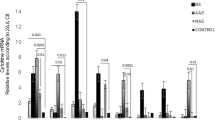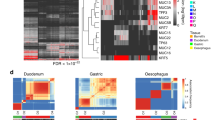Abstract
It has been proposed recently that gastroesophageal reflux disease (GERD) patients may be categorized into three distinct groups exhibiting non-erosive reflux disease (NERD), erosive reflux disease (ERD), and Barrett’s esophagus (BE). Measurement of relative gene expression levels was undertaken to identify distinct molecular subclasses in different variants of gastroesophageal disease. The measurements were made with Affymetrix U133A 2.0 GeneChips and RNA isolated from mucosal samples of normal squamous esophageal epithelium from 24, 28, and 26 patients with NERD, ERD and BE, respectively. Statistical testing of microarray data showed that gene expression profiles are discriminative for BE and NERD, but not for combinations of BE and ERD or NERD and ERD. In addition, women developing NERD exhibited transcriptional patterns that differed from those of men with BE. In clustering analyses, we did not observe correlations between sex and assignment of gene expression profile of ERD patients to either the NERD or the BE group. Although the biological significance of the identified genes remains uncertain, we hypothesize that GERD is a monophyletic disease that develops with the onset of gastroesophageal reflux and represents two main molecular classes, which may result in different progressions to inflammatory process within esophageal epithelium modulated by sexual dimorphism. While normal epithelium samples from NERD and BE patients are molecularly homogeneous, esophageal mucosa from ERD patients is molecularly similar to either NERD or BE. These findings may be useful for defining molecular markers which could predict potential progression to Barrett’s metaplasia among patients with reflux disease.






Similar content being viewed by others
References
Fass R, Ofman JJ (2002) Gastroesophageal reflux disease—should we adopt a new conceptual framework? Am J Gastroenterol 97:1901–1909
Isolauri J, Luostarinen M, Isolauri E, Reinikainen P, Viljakka M, Keyrilainen O (1997) Natural course of gastroesophageal reflux disease: 17–22 year follow-up of 60 patients. Am J Gastroenterol 92:37–41
Pace F, Santalucia F, Bianchi Porro G (1991) Natural history of gastro-oesophageal reflux disease without oesophagitis. Gut 32:845–848
Chal KL, Stacey JH, Sacks GE (1995) The effect of ranitidine on symptom relief and quality of life of patients with gastro-oesophageal reflux disease. Br J Clin Pract 49:73–77
Tew S, Jamieson GG, Pilowsky I, Myers J (1997) The illness behavior of patients with gastroesophageal reflux disease with and without endoscopic esophagitis. Dis Esophagus 10:9–15
Fass R, Fennerty MB, Vakil N (2001) Nonerosive reflux disease—current concepts and dilemmas. Am J Gastroenterol 96:303–343
Rinn JL, Snyder M (2005) Sexual dimorphism in mammalian gene expression. Trends Genet 21:298–305
Banki F, Demeester SR, Mason RJ, Campos G, Hagen JA, Peters JH, Bremner CG, Demeester TR (2005) Barrett’s esophagus in females: a comparative analysis of risk factors in females and males. Am J Gastroenterol 100:560–567
Wu Z, Irizarry RA (2004) Preprocessing of oligonucleotide array data. Nat Biotechnol 22:656–658; author reply 658
Benjamini Y, Hochberg Y (1995) Controlling The False Discovery Rate - A Practical And Powerful Approach To Multiple Testing. J R Stat Soc Ser B Stat Methodol 57:289–300
Eisen MB, Spellman PT, Brown PO, Botstein D (1998) Cluster analysis and display of genome-wide expression patterns. Proc Natl Acad Sci USA 95:14863–14868
Mikula M, Dzwonek A, Jagusztyn-Krynicka K, Ostrowski J (2003) Quantitative detection for low levels of Helicobacter pylori infection in experimentally infected mice by real-time PCR. J Microbiol Methods 55:351–359
Muller PY, Janovjak H, Miserez AR, Dobbie Z (2002) Processing of gene expression data generated by quantitative real-time RT-PCR. Biotechniques 32:1372–1374, 1376, 1378–1379
Ge X, Yamamoto S, Tsutsumi S, Midorikawa Y, Ihara S, Wang SM, Aburatani H (2005) Interpreting expression profiles of cancers by genome-wide survey of breadth of expression in normal tissues. Genomics 86:127–141
Galfalvy HC, Erraji-Benchekroun L, Smyrniotopoulos P, Pavlidis P, Ellis SP, Mann JJ, Sibille E, Arango V (2003) Sex genes for genomic analysis in human brain: internal controls for comparison of probe level data extraction. BMC Bioinformatics 4:37
Shedden K, Chen W, Kuick R, Ghosh D, Macdonald J, Cho KR, Giordano TJ, Gruber SB, Fearon ER, Taylor JM, Hanash S (2005) Comparison of seven methods for producing Affymetrix expression scores based on false discovery rates in disease profiling data. BMC Bioinformatics 6:26
Carrel L, Willard HF (2005) X-inactivation profile reveals extensive variability in X-linked gene expression in females. Nature 434:400–404
Souza RF, Shewmake KL, Shen Y, Ramirez RD, Bullock JS, Hladik CL, Lee EL, Terada LS, Spechler SJ (2005) Differences in ERK activation in squamous mucosa in patients who have gastroesophageal reflux disease with and without Barrett’s esophagus. Am J Gastroenterol 100:551–559
Wang X, Weng LP, Yu Q (2000) Specific inhibition of FGF-induced MAPK activation by the receptor-like protein tyrosine phosphatase LAR. Oncogene 19:2346–2353
Isomoto H, Kanazawa Y, Nishi Y, Wen CY, Inoue K, Kohno S (2005) Expression of CXC receptor 1 and 2 in esophageal mucosa of patients with reflux esophagitis. World J Gastroenterol 11:1793–1797
Naito Z (2005) Role of the small leucine-rich proteoglycan (SLRP) family in pathological lesions and cancer cell growth. J Nippon Med Sch 72:137–145
Lappas M, Permezel M, Rice GE (2005) Leptin and adiponectin stimulate the release of proinflammatory cytokines and prostaglandins from human placenta and maternal adipose tissue via nuclear factor-kappaB, peroxisomal proliferator-activated receptor-gamma and extracellularly regulated kinase 1/2. Endocrinology 146:3334–3342
Yu MK, Moos PJ, Cassidy P, Wade M, Fitzpatrick FA (2004) Conditional expression of 15-lipoxygenase-1 inhibits the selenoenzyme thioredoxin reductase: modulation of selenoproteins by lipoxygenase enzymes. J Biol Chem 279:28028–280235
Da Silva JA (1999) Sex hormones and glucocorticoids: interactions with the immune system. Ann N Y Acad Sci 876:102–117; Discussion 117–118
Moons LM, Kusters JG, Bultman E, Kuipers EJ, van Dekken H, Tra WM, Kleinjan A, Kwekkeboom J, van Vliet AH, Siersema PD (2005) Barrett’s oesophagus is characterized by a predominantly humoral inflammatory response. J Pathol 207:269–276
Acknowledgements
This work was supported by grants from the Polish Committee for Scientific Research (PBZ-KBN-091/P05/2003/43 and KBN-P05A-131-25). J.O.’s work was also supported by a Scholar Grant from the Foundation for Polish Science. LSW was supported by a Program for Young Researchers from the Foundation for Polish Science.
Author information
Authors and Affiliations
Corresponding author
Additional information
Supplementary data and all MIAME compliment microarray data are available at: http://gastrolab.coi.waw.pl/.
Rights and permissions
About this article
Cite this article
Ostrowski, J., Rubel, T., Wyrwicz, L.S. et al. Three clinical variants of gastroesophageal reflux disease form two distinct gene expression signatures. J Mol Med 84, 872–882 (2006). https://doi.org/10.1007/s00109-006-0083-z
Received:
Accepted:
Published:
Issue Date:
DOI: https://doi.org/10.1007/s00109-006-0083-z




